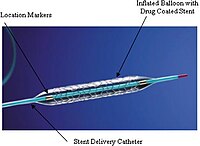
Photo from wikipedia
Background Studies comparing coronary artery bypass graft (CABG) and percutaneous coronary intervention (PCI) have largely been performed in the bare-metal stent (BMS) and first-generation drug eluting stent (F-DES) era. Second-generation… Click to show full abstract
Background Studies comparing coronary artery bypass graft (CABG) and percutaneous coronary intervention (PCI) have largely been performed in the bare-metal stent (BMS) and first-generation drug eluting stent (F-DES) era. Second-generation DES (S-DES) have shown improved outcomes when compared to F-DES, but data comparing CABG with PCI using S-DES is limited. We compared mortality following CABG versus PCI for patients with multivessel disease and analyzed different stent types. Methods A total of 6,682 patients underwent multivessel revascularization at Harefield Hospital, UK. We stratified CABG patients into single arterial graft (SAG) or multiple arterial grafts (MAG); and PCI patients into BMS, F-DES or S-DES groups. We analyzed all-cause mortality at 5 years. Results 4,388 patients had CABG (n[SAG] = 3,358; n[MAG] = 1,030) and 2,294 patients had PCI (n[BMS] = 416; n[F-DES] = 752; n[S-DES] = 1,126). PCI had higher 5-year mortality with BMS (HR = 2.27, 95% CI:1.70–3.05, p<0.001); F-DES (HR = 1.52, 95% CI:1.14–2.01, p = 0.003); and S-DES (HR = 1.84, 95% CI:1.42–2.38, p<0.001). This was confirmed in inverse probability treatment weighted analyses. When adjusting for both measured and unmeasured factors using instrumental variable analyses, PCI had higher 5-year mortality with BMS (Δ = 15.5, 95% CI:3.6,27.5, p = 0.011) and FDES (Δ = 16.5, 95% CI:6.6,26.4, p<0.001), but had comparable mortality with CABG for PCI with SDES (Δ = 0.9, 95% CI: -9.6,7.9, p = 0.844), and when exclusively compared to CABG patients with SAG (Δ = 0.4, 95% CI: -8.0,8.7, p = 0.931) or MAG (Δ = 4.6, 95% CI: -0.4,9.6, p = 0.931). Conclusions In this real-world analysis, when adjusting for measured and unmeasured confounding, PCI with SDES had comparable 5-year mortality when compared to CABG. This warrants evaluation in adequately-powered randomized controlled trials.
Journal Title: PLoS ONE
Year Published: 2018
Link to full text (if available)
Share on Social Media: Sign Up to like & get
recommendations!